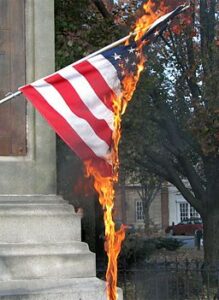Burning the Flag in Protest
The burning of the American flag in protest during the 1960s was a symbol of protest and a way for people to express their dissent with the government and the Vietnam War. During this time, there was a growing anti-war movement and many felt that the government was not listening to their voices. The flag, as a symbol of the country and the government, became a target of protest.
 Flag burning was a powerful and controversial form of protest. It was seen by some as a disrespectful and unpatriotic act, while others saw it as a form of free speech protected by the First Amendment. The act of burning the flag was meant to challenge the government and bring attention to the issues being protested. It was a way to make a statement and send a message that could not be ignored.
Flag burning was a powerful and controversial form of protest. It was seen by some as a disrespectful and unpatriotic act, while others saw it as a form of free speech protected by the First Amendment. The act of burning the flag was meant to challenge the government and bring attention to the issues being protested. It was a way to make a statement and send a message that could not be ignored.
Supreme Court Case
In 1969, the U.S. Supreme Court heard the case of Street v. New York, which dealt with the issue of flag burning. The Court ruled that the act of flag burning was a form of symbolic speech protected by the First Amendment. This ruling established the right of citizens to express their dissent through flag burning, even if it was seen as offensive by some.
Despite the Supreme Court’s ruling, flag burning remained a controversial issue in the following years. Many people felt that it was disrespectful to the flag and to the country, and sought to have the act made illegal. In 1989, the U.S. Supreme Court heard the case of Texas v. Johnson, which dealt with the issue of flag burning. The Court reaffirmed its previous ruling, stating that flag burning was protected as a form of symbolic speech under the First Amendment.
So flag burning in the 1960s was a form of protest used by those who felt that their voices were not being heard by the government. It was a powerful symbol of dissent that sparked intense debates about freedom of speech and the role of the flag as a symbol of the country. Despite the controversy it generated, the Supreme Court’s rulings have established the right of citizens to express their dissent through flag burning, making it a part of the country’s rich history of protest and dissent.
Flag Desecration Laws
Nearly every administration, Republican and Democratic, has tried to add flag desecration laws since the 1969 ruling. None have been able to resolve the conflict between the despicable act, and the overriding right to free speech that is guaranteed in the first amendment. Mitch McConnell summed it up as :
The vast majority of Americans honor the flag, and rightly so. Some would go so far as to amend the Constitution to protect the flag against those who would burn it. While I share and admire their patriotism, altering our First Amendment, even for the worthy purpose of protecting the flag, is not a position I can support.
Make no mistake, I treasure the Stars and Stripes as much as any American. One of my most prized possessions is the flag which honored my father’s military service in World War II. It was draped upon his coffin after his death from cancer in 1990. He fought in the European theater to protect the freedoms that the flag represents, and it now rests proudly on the mantle in my Senate office.
I don’t share the slightest shred of sympathy with any who would dare desecrate the flag. They demean the service of millions of Americans, including my father and the brave men and women currently fighting the War on Terror. They deserve rebuke and condemnation, if not a punch in the nose.
I revere the American flag as a symbol of freedom. But behind it is something larger, the Constitution. The First Amendment, which protects our freedom of speech, is the most precious part of the Bill of Rights. As disgusting as the ideas expressed by those who would burn the flag are, they remain protected by the First Amendment.
As a writer, I reluctantly have to agree.